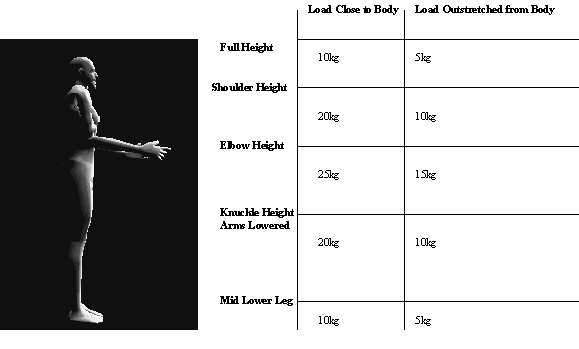Manual Handling Regulations 1992
Overview
The incorrect handling of loads causes large numbers of injuries and can result in pain, time off work and sometimes permanent disablement. In fact, more than a quarter of all accidents reported each year to the enforcing authorities are associated with manual handling.
The Manual Handling Operations Regulations 1992 do not, as is often believed, set legal limits for weights that can be lifted. Nor do they explicitly require training in manual handling techniques to be given - in fact they are one of the few sets of modern Regulations without an explicit training requirement contained within them.
Rather, the Regulations require, where reasonably practicable, that manual handling is eliminated. Where it cannot be eliminated, then a risk assessment must be carried out where there is a risk of injury due to the manual handling operation.
"Manual handling operations" are defined in the Regulations to mean "any transporting or supporting of a load (including the lifting, putting down, pushing, pulling, carrying or moving thereof) by hand or by bodily force". "Injury" is defined to exclude "injury caused by any toxic or corrosive substance" . Whereas, "load" is defined to include "any person and any animal". (Regulation 2).
The Regulations require employers to carry out the following 3 key steps:
- Avoid hazardous manual handling operations where reasonably practicable. Consider whether the load must be moved at all. And if it must, whether it can be moved mechanically, for example, by fork-lift truck.
- Assess adequately any hazardous operations that cannot be avoided. An ergonomic assessment should look at more than just the weight of the load. It should consider the shape and size of the load; the way the task is carried out (e.g. the handler's posture); the working environment (e.g. is it cramped or hot?); the individual's capability (e.g. is unusual strength required?). Unless the assessment is very simple a written record of it will be needed.
- Reduce the risk or injury as far as reasonably practicable. A good assessment will not only show whether there is a problem but will also point to where the problem lies. That is the starting point for improvements. For example, if the load is bulky or heavy it may be possible to use mechanical handling aids or break down the load. If handlers have to adopt an awkward posture it may be possible to rearrange the task. Additional training may be required.
The main requirements of the Manual Handling Operations Regulations can be briefly outlined as follows:
- Employers, so far as reasonably practicable, shall avoid the need for employees to undertake any manual handling operations at work which involve a risk of their being injured. (Regulation 4).
- Where it is not reasonably practicable to avoid the need for employees to undertake manual handling operations at work which involve a risk of their being injured, the employer shall carry out a suitable and sufficient assessment of all such manual handling operations. The assessment needs to consider the following: Task, Individual, Environment, Load and any Other Factors which might affect the manual handling operation. The assessment shall be reviewed where there is reason to suspect that it is no longer valid or where there has been a significant change. Where the review suggests changes to the assessment, the employer shall make them. (Regulation 4).
- The employer shall take appropriate steps to reduce the risk of injury to employees undertaking manual handling operations to the lowest level reasonably practicable. (Regulation 4).
- The employer shall provide employees undertaking manual handling operations general indications and, where reasonable practicable, precise information on the weight of each load and the heaviest side of any load whose centre of gravity is not positioned centrally. (Regulation 4).
- Employees, while at work, shall make full and proper use of any system of work provided for their use by the employer. (Regulation 5).
Brief Guidance Concerning The Manual Handling Operations Assessment
While deciding whether or not a risk of injury exists with regard to a particular manual handling operation, the following guidance may prove helpful.
Where the operation is well within the guidance figures, a simple check list will suffice. Where the operation is close to the guidance figures, a more detailed assessment will be needed. Where the operation exceeds the guidance figures by twice as much, the operation should be subject to close scrutiny.
Put simply, a 10kg load carried close to the body between shoulder and knuckle height is well within the "boundary condition" given by the above diagram (20-25kg) and a very simple assessment would be enough. The same load carried outstretched at shoulder to elbow height would be close to the boundary condition and require a detailed assessment. The same load carried outstretched at either above shoulder height or below mid lower leg height would be twice the boundary condition (5kg) and require close scrutiny.
In addition, the following factors have to be taken into account when comparing the actual manual handling operation with the boundary conditions illustrated in the diagram above.
- Lower the guideline figures by 10% where the handler twists through 45º and by 20% where they twist through 90º.
- Reduce the guideline figures by a third to offer same degree of protection to nearly all women as to nearly all men.
- The guideline figures are for infrequent operations (up to 30 operations per hour), reduce by 30% where repeated once or twice per minute, by 50% where repeated five to eight times per minute and by 80% where repeated more than about 12 times per minute.
- Reduce guideline figures where the load is carried further than 10m without a rest.
- Where a load involves pushing or pulling, the guideline figure for starting or stopping the load is 25kg (10kg for keeping the load in motion).
- The guideline figure for lifting while in the seated position is 5kg, close to the body, between the lower trunk and shoulder height.